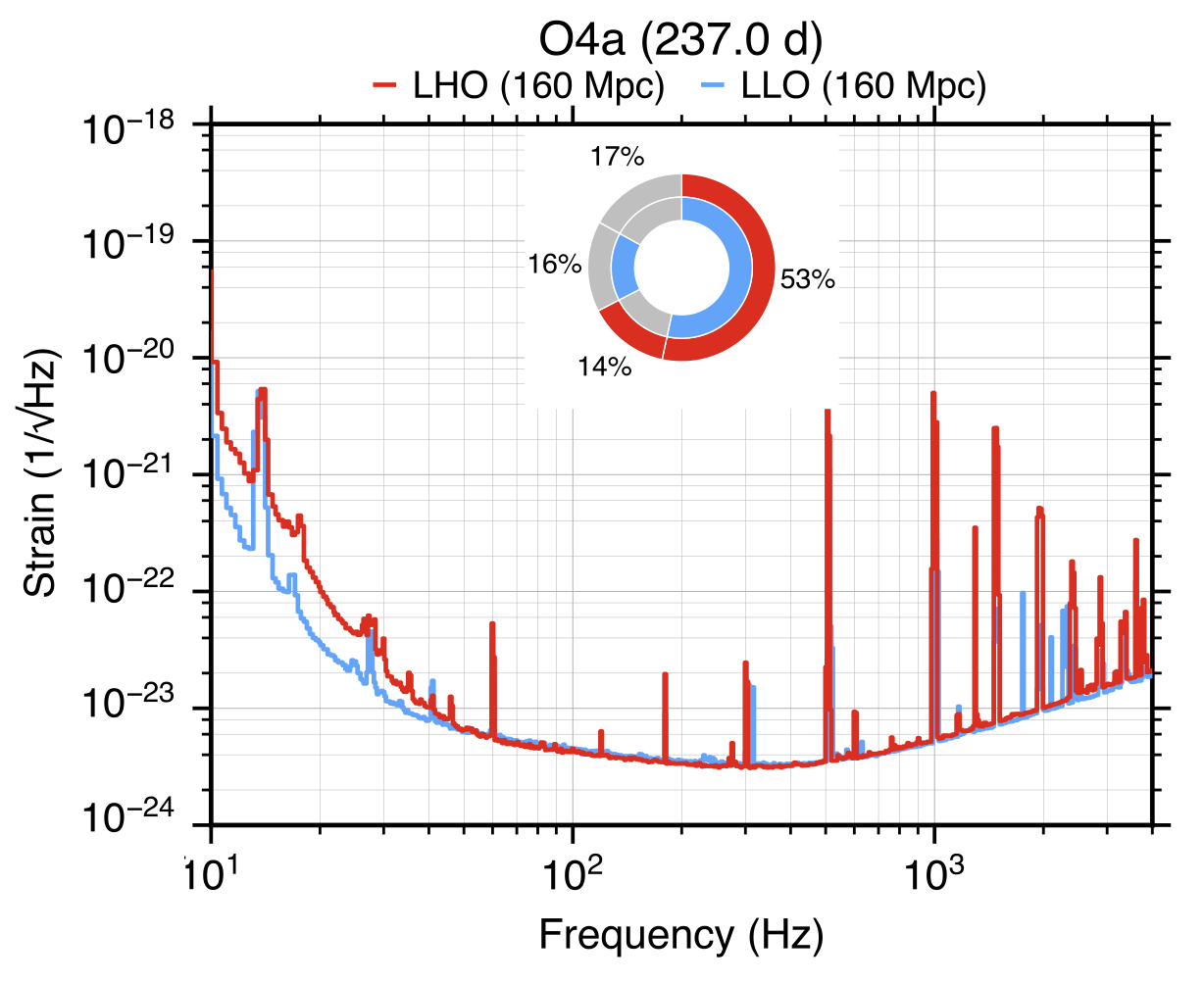The O4a Data Release
Run Overview
- The fourth LIGO-Virgo-KAGRA observation run (O4) is divided in three parts: O4a, O4b and O4c.
- O4a dates: 24th May 2023 15:00 UTC (GPS 1368975618) to 16th Jan 2024 16:00 UTC (GPS 1389456018).
- Few segments of data from the days immediately prior to the start of the run were used for the analyses of the supernova SN2023ixf and the GW230518_125908 event, so they have been added to this release. The start of the data release is thus the 15th May 2023 at UTC 14:13:22 (GPS 1368195220).
- Data are available from two detectors: LIGO Hanford (H1) and Livingston (L1).
- Data are available at the original 16 KHz and the downsampled 4KHz sample rates.
- In addition to the final version of the strain data, a few additional versions are also available.
Get O4a Data
- Strain Data: 4 kHz Data 16 kHz Data
- Md5 checksums for 4KHz data: All 4KHz HDF5 files | All 4KHz GWF files
- Md5 checksums for 16KHz data: All 16KHz HDF5 files | All 16KHz GWF files
- Segments: Timeline Data Quality
- Detections: GWTC-4.0
- Cluster Access: OSDF
GWF Channel Names
The final version of the strain data, available using the buttons above, is sourced from the channels:
H1:GDS-CALIB_STRAIN_CLEAN_ARL1:GDS-CALIB_STRAIN_CLEAN_AR
See the technical details page for the channel names used in the O4a 4 kHz and 16 kHz GWF files (ending with extension .gwf).
Alternate Strain Release
In addition to the final version of the strain data, several additional versions are also available, including different cleaning methods.
- See Alternate Strain Release for how to access these channels.
Auxiliary Data Release
The interferometers use hundreds of thousands of sensors to check the status of each subsystem of the instrument and the local environment. These measurements are stored as time series data, called auxiliary channels. A set of channels used for data cleaning and to produce data-quality flags are added to this data release.
- See Auxiliary Data Release for how to access these channels.
O4a Detector Performance
- O4a Summary Statistics
- Advanced LIGO detector performance in the fourth observing run (arXiv:2411.14607)
- GWTC-4.0: An Introduction to Version 4.0 of the Gravitational Wave Transient Catalog (arXiv:2508.18080)
Astrophysical Results
Papers including results from O4a can be found following the links below:
- LIGO-Virgo-KAGRA Publications Page
- Observation of Gravitational Waves from the Coalescence of a 2.5-4.5 M_sun Compact Object and a Neutron Star
- Search for gravitational waves emitted from SN 2023ixf
- GW231123: a Binary Black Hole Merger with Total Mass 190-265 M_sun (arXiv:2507.08219)
- GWTC-4.0 GWOSC web page
- GWTC-4.0: Updating the Gravitational-Wave Transient Catalog with Observations from the First Part of the Fourth LIGO-Virgo-KAGRA Observing Run (arXiv:2508.18082)
Data-Quality Segments
Download Segments
- The DATA segment list indicates times when data are publicly available.
- See the Timeline Query Page for other O4a segment lists.
Segments Documentation
- The papers LIGO Detector Characterization in the first half of the fourth Observing run and Open Data from LIGO, Virgo, and KAGRA through O4a describe data-quality categories.
- See also the technical details page
Hardware Injections
The O4a data set contains simulated astrophysical signals, known as hardware injections, used for testing and calibration.
For an example, see the Find a Hardware Injection Tutorial (in the tutorial use the flags for the O4a run described here).
For complete documentation, see:
Instrumental Spectral Lines
A power spectral density of LIGO data typically shows a number of spectral lines. Many of these are associated with known instrumental resonances. The O4a instrumental spectral lines page gives an explanation, and catalog, of these instrumental lines.
Representative PSDs

- The above plot is reproduced from the GWTC-4.0 Catalog paper Introduction. LHO and LLO stand for LIGO Hanford Observatory and LIGO Livingston Observatory. In the title, next to the detectors name, the user find their BNS inspiral ranges during O4a as defined in the paper. Inset sunburst charts show the fraction of the run duration during which different combinations of detectors were observing. Gray regions in each ring indicates portions when a detector is not operating.
- Plots of daily sensitivity are available on the archived detector status pages
Technical Details
GWOSC 4 kHz strain data have been repackaged and downsampled from 16384 Hz to 4096 Hz. Advanced LIGO and advanced Virgo data are not calibrated or valid below 10 Hz or above 5 kHz, and the data sampled at 4096 Hz are not valid above about 1700 Hz. In most searches for astrophysical sources, data below 20 Hz are not used because the noise is too high. More detailed information about the data set can be seen on the Technical Details page.
Acknowledge
To acknowledge the use of O4a data, see the Acknowledgement Page.
Data Set DOI: https://doi.org/10.7935/kt51-6n86.
Revision History
- August 26, 2025: First release
